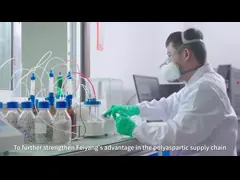Product Details
For many years, polyurethane materials and epoxy coatings have been
widely used for waterproofing in various construction facilities.
With the emergence of polyurea, the overall level of waterproofing
projects has taken a new leap forward.
Polyurea waterproofing technology organically integrates new
materials, new facilities, and new processes. It represents a
revolutionary leap from traditional construction techniques and is
currently one of the most advanced waterproofing construction
technologies internationally.
Advantages of Polyurea Waterproofing
- Rapid curing, allowing continuous spraying on both horizontal and
vertical surfaces without sagging.
- Not sensitive to humidity or temperature, with good thermal
stability.
- 100% solid content, VOC-free, pollution-free, and environmentally
friendly.
- Excellent physical properties with strong adhesion to concrete
substrates.
- Seamless coating, providing superior waterproofing performance.
- High elongation rate, resistant to cracking under thermal cycling.
- Good weather resistance, no powdering or discoloration.
Applications and Construction of Polyurea Waterproofing
Usage: Polyurea waterproofing materials are mainly used for rooftop
waterproofing of high-end building facilities, industrial
factories, vapor barriers in cold storage, reservoirs, bridges,
tunnels, underground projects, cooling towers in power plants,
wastewater treatment ponds, aquariums, swimming pool liners, and
other areas.
Roof Waterproofing
The construction process of polyurea coatings consists of substrate
preparation, priming, and polyurea topcoat application.
- Substrate preparation is key to ensuring construction quality. This
can be divided into metal substrate and concrete substrate
preparation. For metal substrate, first, sandblast the substrate to
Sa2.5 level. For defects like weld seams, use epoxy filler to level
it. After the epoxy filler has cured, grind it smooth with an angle
grinder. Then, clean the substrate and apply two coats of the
corresponding primer either by rolling or brushing. For concrete
substrate, treat the precast concrete with shot blasting or remove
surface dust and residues using an angle grinder or a high-pressure
water jet. Once the substrate is completely dry, use a filler to
level the surface. For areas that need filling, grind them smooth
with an angle grinder after the filler has cured. Afterward, remove
surface contaminants and apply a coat of the corresponding primer.
- The maximum interval between the application of the primer coats is
24 hours, and the minimum is 3 hours.
- The polyurea topcoat should be applied between 3 to 168 hours after
the primer application. If the interval exceeds 168 hours, reapply
a coat of primer a day before the polyurea application. Before
applying the topcoat, use dry high-pressure air to blow away any
surface dust.
Feiyang has been specializing in the production of raw materials
for polyaspartic coatings for 30 years and can provide polyaspartic
resins, hardeners and coating formulations. Some of our
polyaspartic coating formulations: Polyaspartic Coating
Feel free to contact us: marketing@feiyang.com.cn
Our products list:
Learn more polyaspartic knowledge: Polyaspartic FAQ
Company Profile
Shenzhen Feiyang Protech Corp., Ltd. specializes in researching and
producing polyaspartic polyurea resin and other new chemical
products. We are recognized as a "National Special New Key Little
Giant" and a "State-level High-tech Enterprise", with more than 50
polyaspartic polyurea invention patents. We also participated in
the preparation of 13 industry standards for polyaspartic polyurea
materials as a leading company in this field, ranking No.1 in the
Chinese market.
In the coating industry, polyaspartic polyurea is used in
construction machinery, automobile, containers, fan blades, marine
heavy corrosion protection, and high-end industrial and commercial
floor coatings. In the adhesive field, it is mainly used in
sealants, stone adhesives, electronic adhesives, film circuit
packaging adhesives, and other high-end applications. In the
waterproofing materials sector, it is primarily used in
hydroelectric dams, water parks, building waterproofing repair
materials, and other areas. In the structural materials field, it
is applied to curling tracks, artificial ice skating rinks, and
other structural materials.
Polyaspartic polyurea is considered a high-end new material in the
strategy of manufacturing power. We have broken the foreign
technology monopoly and filled the domestic market gap. Due to its
comprehensive characteristics of "Environmental protection, Energy
saving, and Long durability", polyaspartic polyurea can contribute
to the realization of genuine carbon neutrality in the coatings,
adhesives, and materials industries.

Since 2012, Feiyang polyaspartic ester resin has been supplied
overseas. It has been widely used to replace Bayer's current
polyaspartic system in many coating companies and has been applied
in anti-corrosion and waterproofing by international coating
companies.




